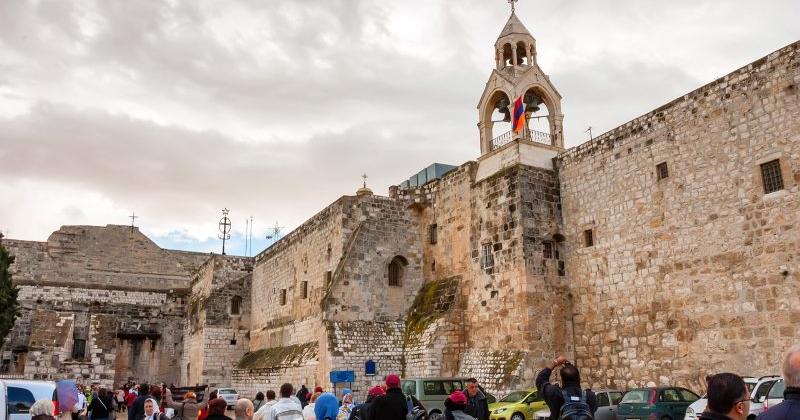Bethlehem’s rich history can be fully appreciated only by walking its streets. Every year, the city enters millions of homes worldwide through the image of the humble manger where Jesus was born. But that image does not compare to experiencing the Old City first-hand. Coming to Bethlehem is a unique experience that I would encourage everyone to pursue.
Unfortunately, while visitors to Bethlehem have increased in number during the past year, many are unable to explore the city properly. Under Israeli occupation, obstacles hindering the normal development of tourism in Palestine have prevented thousands of people from experiencing what Bethlehem has to offer.
For example, I often hear from Palestinian priests that “in this land, we receive many tourists yet very few pilgrims”. In other words, there are more visitors interested in seeing the stones than in meeting the living stones. This is one consequence of Israel’s monopoly over the tourist industry. Israel has little interest in encouraging visitors to interact with Palestinians or to learn about their heritage.
It is hard to imagine that visitors motivated by faith or a sense of history would not want to meet the stewards of the holy sites they are visiting. Pope John Paul II said it best during his pilgrimage in 2000, when he told Palestinians during a visit to the Dheisheh refugee camp: “Probably the pastors and shepherds of Bethlehem were your predecessors, your ancestors.”
The Church of the Nativity is of seminal importance to all Christians, whatever their denomination. And yet we still must go to great lengths to persuade people to visit it. Even more shocking, when we sought to list the church as a UNESCO World Heritage Site, some countries, succumbing to Israeli and American pressure, opposed the designation.
Still, we succeeded, and we are now busy with the important work of preserving this cherished site. I am proud to say that this will be the last Christmas before the restoration of the church is complete. Soon, visitors will be able to see newly discovered mosaics and the church’s original floor, all of which date back to the fourth century. After that, they can visit other landmarks of the Old City, including Star Street, the pilgrimage route taken by Joseph and Mary, which we are transforming into a place full of life.
Indeed, Bethlehem’s cultural heritage extends well beyond the walls of the Church of the Nativity. The richness of the city has long been documented, including by European explorers who visited in the 19th century. In the Frenchman Victor Guérin’s “Description of Palestine”, published in 1875, one finds a city full of life, and divided into at least eight quarters. Visitors encountered the splendid architecture of the Anatra Quarter, and learned about Palestine’s oldest still-functioning school, the Terra Sancta College, which dates back to 1598. The same cannot be said for most visitors today.
Bethlehem’s cuisine is also a treasure. From fresh baked goods, falafel and hummus to a chef’s table stocked with produce from the Battir Gardens, Bethlehem’s richness of fare is rare for a small city. Battir Gardens, another World Heritage Site just 15 minutes from the city centre, offers breathtaking agricultural terraces, hiking trails, vines and olives that offset the ugly Israeli settlements and walls encircling the city. As a result of those settlements, the Palestinian government’s remit applies to a mere 13 per cent of the district’s total land area.
Bethlehem is no stranger to the challenges facing all of Palestine. The Trump administration’s recognition of Jerusalem as Israel’s capital has encouraged the Israeli government to increase colonisation in and around East Jerusalem, which severely affects Bethlehem. With racist laws increasingly dividing our families, some have lost all hope for a political solution, and opted for immigration instead.
But the scars of occupation do not tell the whole story. The thousands of Palestinians, who have stayed in Bethlehem, despite the constant struggle, comprise a thriving and creative civil society, including artists, human rights organisations and businesspeople who continue to pursue opportunities in the name of hope.
The reality for Palestinians today is captured perfectly in a passage from the Book of Jeremiah: “‘Peace, peace,’ they say, when there is no peace.” To that we might add, “‘Hope, hope’ when there is no hope,” because it is our responsibility to keep hope alive. The spirit of hope is what keeps Bethlehem shining brightly, even in the darkness of occupation.
Though Christian Zionists like US Vice President Mike Pence make cynical use of the Bible to justify oppression of the Palestinians, as if denying our rights is a divine mandate, we are nonetheless determined to stand up for Christ’s message of justice, love and peace. There is nothing divine about the system of apartheid emerging around us. The illegal wall that has been built through the heart of our city is antithetical to justice and freedom. Its dismantling would be a blessing.
For the rest of the world, Bethlehem is and must remain a symbol of hope. As home to centuries-old cosmopolitan architecture and dozens of churches of various denominations, the city is a bastion of inclusion. Shepherds Field in Beit Sahour, Saint Nicholas Church and the Cremisan Valley in Beit Jala, St George’s Monastery in Al Khader and Mar Saba all embody faith without fanaticism. But, lest we forget, Bethlehem also hosts three refugee camps, which is a reminder of the injustice visited upon Palestinians during the Nakba (catastrophe), when hundreds of thousands of Palestinians, expelled from their homes in 1948, sought refuge here.
After more than 2,000 years, Bethlehem’s message of hope to the world remains unchanged. All are invited to come experience it first-hand.
